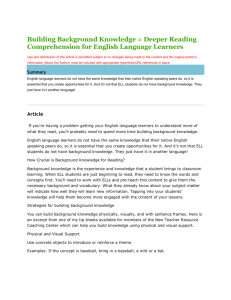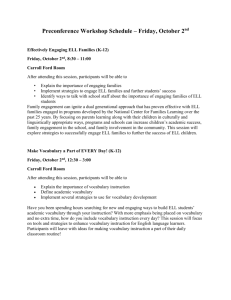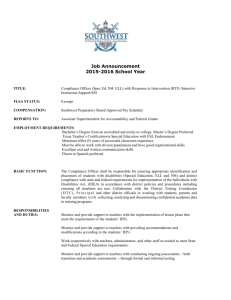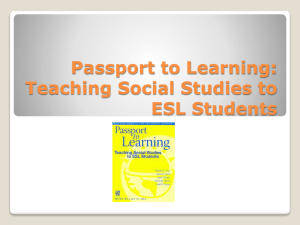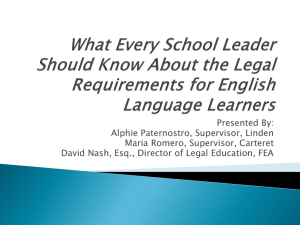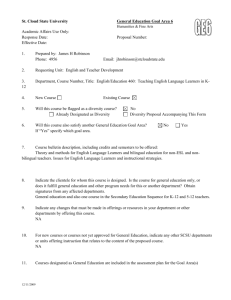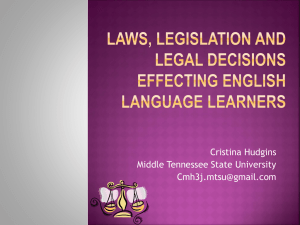Effective Instruction for English Language Learners
advertisement
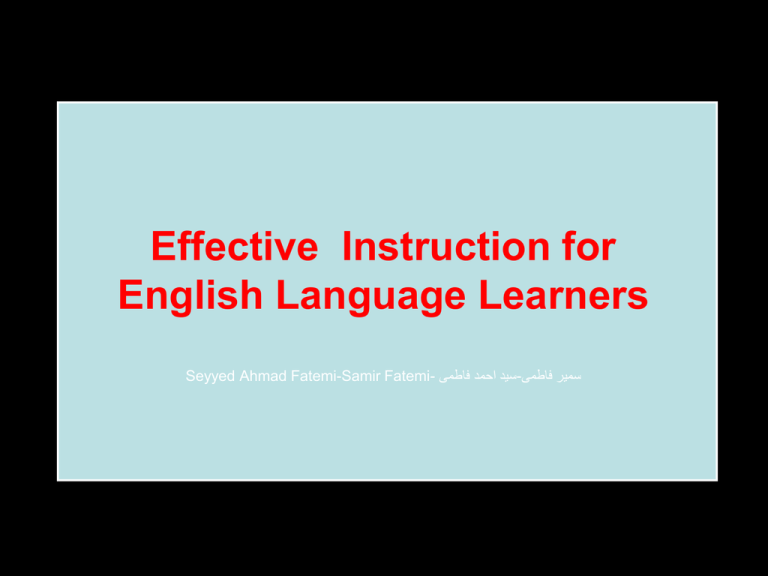
Effective Instruction for English Language Learners Seyyed Ahmad Fatemi-Samir Fatemi- سید احمد فاطمی-سمیر فاطمی Agenda •Dialogue Demonstration Application •By the end of the session you will have more: •knowledge about the unique needs of ELL’s •strategies to implement this fall •confidence to plan and modify lessons for ELL’s •enthusiasm for teaching ELL’s • • • • Dialogue: What do you know about English Language Learners? Your own experiences or What you’ve learned •“exploding demographics” •(Flores, 1994) Issues • home language/school language • time required to learn English • instructional resources • classroom segregation • teacher capacity Instruction! • “English learners are best served when their teachers provide instruction-including corrective feedback--when it is needed.” • Source: (Scarcella, 2004, p. 53) • “The most powerful way of learning academic English is through good instruction.” • Source: (Scarcella, 2004, p. 53) Big Ideas • Increase academic vocabulary: multiple encounters with words. Automaticity with sight words Oral language development: lots of dialogue Big Ideas • Safety nets of increased context: e.g., visuals Focus on comprehension through strategic, analytic reading and think-alouds-explicit instruction! Don’t make assumptions-check for understanding often Second Language Acquisition • • • • Natural Order (Krashen): pre-production, speech emergence, intermediate, advanced Affective Filter (Krashen) Comprehensible Input (Krashen) Output (productive speech) (Swain) • • • • • Natural Order (Krashen): pre-production speech emergence intermediate advanced • TELPAS • • • • Beginner (B) Intermediate (I) Advanced (A) Advanced High (AH) • • • • • • What ELL’s Bring: Linguistic Transfer from L1 Prior knowledge/declarative knowledge Strategic/procedural knowledge Motivation to learn English Cultural and linguistic resources “Funds of Knowledge” What ELL’s need: •Vocabulary/Academic English • English Grammar •Increased CONTEXT • • • • • • • Modifications: VOCABULARY focus Visuals/video/multimedia Hands-on Real Objects Preview-TEACH-Review Small group/partner work • “Unstructured and unplanned grammar instruction is a disaster for ELL’s.” (p. 100) • No on-the-fly instruction! • Source: (Scarcella, 2003) Annenberg Video •http://www.learner.org/resources/s eries204.html •Clip: 17:00-23:00 •Thoughts? •Shared reading component More on oral language development • Singing • Poetry/chart stories • Routines •<Word Study> Sight Words •Automaticity •Word lists •250 words • Source: Bear, D. R., Helman, L., Templeton, S., Invernizzi, M., & Johnston, F. (2007). Words their way with English learners: Word Study for Phonics, Vocabulary, and Spelling Instruction. Columbus, OH: Merrill/Prentice Hall. • 100 most common words= • 50% of words in a text • Source: (Nation, 2005) Word Walls: Build Academic Vocabulary •Interactive-DAILY! •Students contribute synonyms •Student “own” the words--they sign their name. •Word Walls •Visual Scaffolding •<Sheltered English> •What is Sheltered English? •Content learning + language learning •Importance of schema building: front-loading •Pre-reading activities Shared Reading • Advantages of shared reading • Active reading and engaging texts. • Thinking aloud to make meaning explicit. Application Consider a classroom reading book you recently used. What vocabulary or concepts were presented in the book that could cause confusion for ELL Learners? What could you do to scaffold the reading experience that would benefit ELL learners? Turn and Talk 1. What might this look like in your classroom?
